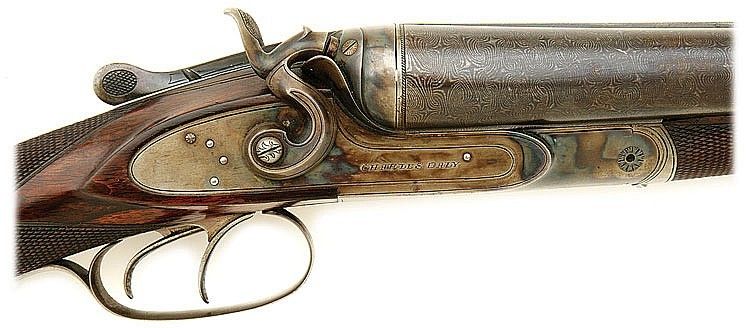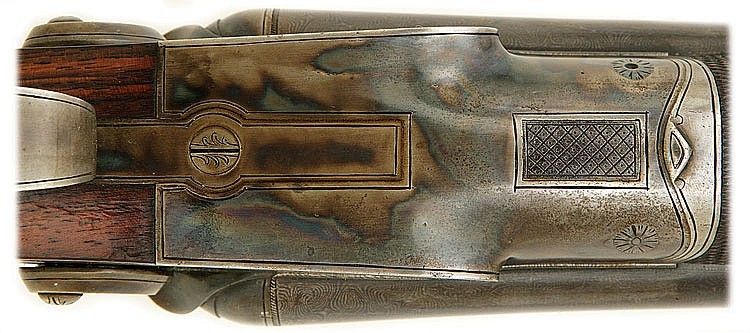Punted to-day on an early, high-condition Charles Daly-branded side-lock, side-by-side hammergun, bought online through the Amoskeag Auction Company. I just happened to remark its availability when reviewing the items on offer after the auction was underway, so I had no time to make an inquiry. The "Charles Daly" brand name is stamped on both side-plates, and the barrels' top-rib is stamped "Charles Daly Damascus Barrels," which despite the lowly grade of the gun overall are very fine damascus, and are 'browned' in their trademark black and white coloration. I have yet to decide what I will eventually do with this gun because it was a surendipitous, impulsive purchase.
The subject gun, a 10-bore wildfowler with 30-inch barrels, and although not engraved as I would normally want it be and the most basic of the early Charles Daly models, is in near new condition. The wonderful French walnut stocks and original case colors were / are irresistibly beautiful.
However, other than the appearance of the gun's "836" serial number in all the expected places, it is otherwise unmarked in terms of identifying stamps, with the exception of the barrel-maker's or barrel set "knitter's" initials immediately behind the forend lug. Those initials, it is said, are "CK". Based on the lack of any other stamps, I believe this is not a Prussian-built gun (Although I would appreciate being corrected concerning this assumption.) but one that was perhaps built in the white and exported by Tolley or Neumann (the lack of proof marks likely precludes this possibility), or some other maker, and imported into the United States by Schoverling, Daly & Gales. When imported for private labeling purposes, the basic gun or parts kit would have been forwarded by them to their retailers / distributors, such as Schaefer & Son, Joseph Tonks, brothers "Jas." and "Wm. Donn" (By the way, I believe that I own the only William Donn, Chicago, gun every built and / or extant, a combined effort of T. Kilby and H. A. Lindner circa 1890-2, and therefore of surpassing quality.), and others for final finishing and to be stamped with the finisher's name and proprietary marks, or simply retailed under the established Charles Daly name. It is possible, too, this gun was manufactured / built and finished in-country by Lefever, although I have not seen other than their so-called 'sidecocker' guns (these said to have been made by H. A. Lindner) associated with the Charles Daly name. I believe this last possibility, or the parallel possibility of some other similarly performing domestic manufacturer, the more likely source because of the dearth of proof and country marks, due to the fact there was not then and is not now a government proof house in the United States, as well as because our domestic gun manufacturers here would have at most applied their maker or brand name and serial numbers (and then only sometimes but not always) to the firearm.
Here is a selection of photographs of the 10-bore Daly gun for your enjoyment:



The key, of course, because this gun lacks another clue, becomes the aforementioned initials "CK" stamped behind the forend hanger or lug. I know that I have seen these initials before, but I have not been able to locate the reference even though I can readily envision them in my mind's eye.
I would greatly appreciate whatever information any correspondent can provide that might assist me in identifying the gun's true maker and /or barrel-maker and / or country of origin, and approximately when made. Thanks to everyone for any and all information, which is always greatly appreciated.
With my
Best regards,
Edwardian
The subject gun, a 10-bore wildfowler with 30-inch barrels, and although not engraved as I would normally want it be and the most basic of the early Charles Daly models, is in near new condition. The wonderful French walnut stocks and original case colors were / are irresistibly beautiful.
However, other than the appearance of the gun's "836" serial number in all the expected places, it is otherwise unmarked in terms of identifying stamps, with the exception of the barrel-maker's or barrel set "knitter's" initials immediately behind the forend lug. Those initials, it is said, are "CK". Based on the lack of any other stamps, I believe this is not a Prussian-built gun (Although I would appreciate being corrected concerning this assumption.) but one that was perhaps built in the white and exported by Tolley or Neumann (the lack of proof marks likely precludes this possibility), or some other maker, and imported into the United States by Schoverling, Daly & Gales. When imported for private labeling purposes, the basic gun or parts kit would have been forwarded by them to their retailers / distributors, such as Schaefer & Son, Joseph Tonks, brothers "Jas." and "Wm. Donn" (By the way, I believe that I own the only William Donn, Chicago, gun every built and / or extant, a combined effort of T. Kilby and H. A. Lindner circa 1890-2, and therefore of surpassing quality.), and others for final finishing and to be stamped with the finisher's name and proprietary marks, or simply retailed under the established Charles Daly name. It is possible, too, this gun was manufactured / built and finished in-country by Lefever, although I have not seen other than their so-called 'sidecocker' guns (these said to have been made by H. A. Lindner) associated with the Charles Daly name. I believe this last possibility, or the parallel possibility of some other similarly performing domestic manufacturer, the more likely source because of the dearth of proof and country marks, due to the fact there was not then and is not now a government proof house in the United States, as well as because our domestic gun manufacturers here would have at most applied their maker or brand name and serial numbers (and then only sometimes but not always) to the firearm.
Here is a selection of photographs of the 10-bore Daly gun for your enjoyment:



The key, of course, because this gun lacks another clue, becomes the aforementioned initials "CK" stamped behind the forend hanger or lug. I know that I have seen these initials before, but I have not been able to locate the reference even though I can readily envision them in my mind's eye.
I would greatly appreciate whatever information any correspondent can provide that might assist me in identifying the gun's true maker and /or barrel-maker and / or country of origin, and approximately when made. Thanks to everyone for any and all information, which is always greatly appreciated.
With my
Best regards,
Edwardian

Comment